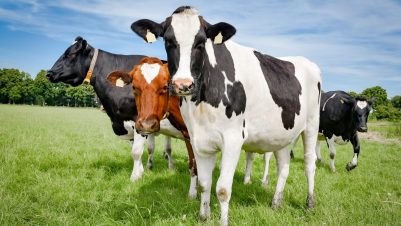The recent outbreak of bluetongue virus (BTV-3) in Holland and Denmark in 2024 has raised significant concerns among vets and livestock producers across Europe. Bluetongue is a viral disease primarily affecting ruminants, particularly sheep, and can lead to severe economic losses in the agricultural sector. As the situation unfolds, and as a notifiable disease, it is imperative for vets in the UK to be aware of the implications of this bluetongue outbreak and to reinforce biosecurity measures to protect livestock health.
Understanding bluetongue virus
Bluetongue is caused by the bluetongue virus, which is transmitted by biting midges, particularly Culicoides species. The disease is characterised by fever and swelling of the face and tongue, and in severe cases, it can be fatal (Figure 1). The virus is endemic in many parts of the world, but outbreaks in non-endemic areas can pose significant risks to local livestock populations.



The recent outbreak in Holland and Denmark has been largely attributed to climatic changes that have expanded the range of the Culicoides vectors, allowing the virus to spread to previously unaffected regions. This highlights the importance of monitoring environmental conditions and vector populations as part of a comprehensive disease management strategy.
Biosecurity measures to mitigate risks
In light of the outbreak, it is crucial for vets in the UK to advocate for and implement robust biosecurity measures on farms. A multifactorial study conducted by a research team at Utrecht University (van den Brink et al., 2024) pinpointed the following strategies that can help mitigate the risks associated with the bluetongue virus.
1. Monitoring and surveillance
Regular monitoring of livestock for signs of bluetongue is essential. Vets should encourage farmers to report any unusual clinical signs promptly. Surveillance programmes can help detect the presence of the virus early, allowing for swift action to contain outbreaks.
2. Grazing animals are at higher risk
The single most powerful risk factor identified in the study was having animals out on grass. Grazing animals, especially in the low- or wetlands, were most susceptible to midges. Some of the examined cows had more than 4,000 bites. Even factors such as bringing the animals inside during peak activity time (around sunset) and just before sunrise appears to reduce the risk in the groups of grazing animals.
Even factors such as bringing the animals inside during peak activity time (around sunset) and just before sunrise appears to reduce the risk in the groups of grazing animals
3. Movement restrictions
Implementing strict movement controls for livestock can prevent the spread of the virus. Movement of animals from regions of many bluetongue-positive farms to “clean” zones increases the risk of more virus-positive midges in the otherwise clear zones. European countries that are currently testing positive for BTV-3 allow the movement of animals from other positive zones. However, the acceptance of animals in transit needs to be cleared with all countries along the route of transport.
4. Vaccination strategies
While there are currently three unauthorised vaccines under licence available for BTV-3 in the UK, vets should stay informed about developments in vaccine research and advocate for vaccination in regions at risk. Vaccination can be an effective tool in controlling the spread of the virus and to reduce the symptoms in already affected herds.
This does, however, rely on vets to monitor the virus type during an outbreak. At the moment, BTV-3 is raging in Scandinavia and the Netherlands, but BTV-12 seems to emerge in the latest report from Holland with the same symptoms. Further, BTV-8, with somewhat more aggressive progressions, is emerging in France.
5. Education and training
Educating farmers and farm workers about the risks associated with bluetongue and the importance of biosecurity is vital. Regular training sessions can help ensure that all personnel are aware of best practices and the signs of infection. Providing resources and guidance on biosecurity protocols can empower farmers to take proactive measures.
Regular training sessions can help ensure that all personnel are aware of best practices and the signs of infection
Most of the animals lost in Denmark have been from secondary bacterial infections or lameness in youngstock. The production loss of approximately 2kg energy corrected milk (ECM) per cow per day seems to have come earlier than expected. That is before the onset of clinical symptoms and continuing for as long as six weeks.
6. Controlling the population of Culicoides
Reducing the population of Culicoides midges is a critical component of biosecurity. This can be achieved through:
- Environmental management: encourage farmers to eliminate standing water and manage vegetation around livestock areas, as these are conducive to midge breeding
- Physical barriers: housing for livestock can limit exposure to midges, particularly during peak activity times
The study by van den Brink et al. (2024) also showed that even though it may seem tempting to start using pesticides to control the Culicoides vectors, there was no true protection gained from the use of any of the available pesticides on the market. This is further documented by Murchie et al. (2019) and de Keyser et al. (2017) who compared different pesticides’ effects on Culicoides. The best effect lasted 10 days.
Even though it may seem tempting to start using pesticides to control the Culicoides vectors, there was no true protection gained from the use of any of the available pesticides on the market
As the drug is administered topically on the back, and midges bite the animals on the soft belly or on the inside of the legs where the concentration is the lowest, the recommendation in Denmark was to not use pesticides to control the midges due to the unnecessary risk of resistance towards deltamethrin and the unwanted side effects on the local environment.
Conclusion
The bluetongue outbreak in Holland and Denmark serves as a stark reminder of the potential threats posed by emerging infectious diseases. For UK vets, the focus must be on enhancing biosecurity measures to protect livestock health. At the time of publication, the count of BTV-3-affected farms in the UK was 168. By implementing robust monitoring, controlling vector populations and educating farmers, the veterinary community can play a crucial role in safeguarding the agricultural sector from the impacts of the bluetongue virus. As the situation evolves, ongoing vigilance and proactive measures will be essential in maintaining the health of livestock and the sustainability of the farming industry.








